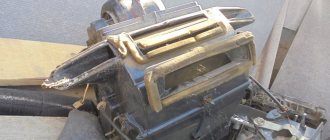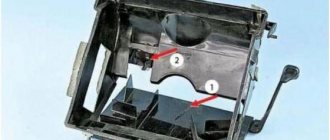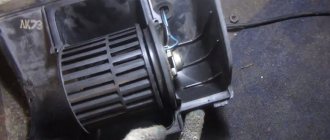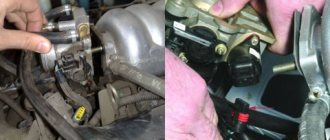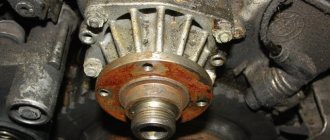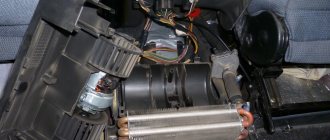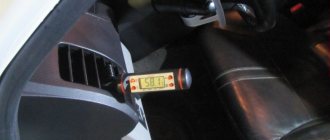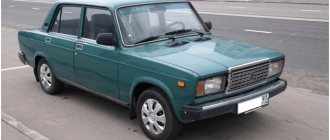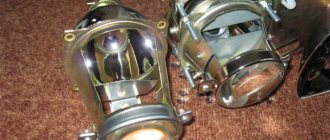The device of the Renault Logan car heater
The heater is located under the dashboard in the central part. The main components of the heater are a fan, distribution dampers and a radiator.
Main components of the Renault Logan heater: 5 - distribution block; 6 — heater radiator; 7 — heater pipelines; 8 — fan resistor; 9 — front left air duct for heating the footwell; 10 — air recirculation control cable; 11 — air distribution control cable; 12 — air temperature control cable
Heater radiator
The central unit of the heating system is the heat exchanger of the heater (stove), or radiator. The main function of the radiator is to heat the air entering the cabin.
The heater radiator is responsible for heating the air entering the cabin
Heater fan
Air is actively supplied to the heater while driving through special holes in the front panel lining. When more intense air supply is needed, the fan comes into play. The faster it rotates, the more air flows to the heating systems.
The fan provides more air to the heater
Heater fan resistor
In physics, a resistor is understood as a passive element of an electrical circuit that can perform different functions: convert current into voltage and vice versa, limit current, absorb electrical energy, etc.
As part of the stove, the resistor is responsible for the operation of the fan, namely: it regulates the rotation speed of its blades. A resistor is connected to the motor and distributes the current, typically providing four fan speeds.
The resistor allows you to adjust the speed of the heater fan
Why does a resistor fail?
The cause of resistor failure is burnout. The fact is that it is constantly energized and transmits current. Experienced craftsmen, however, claim that the failure of the resistor may be associated with malfunctions or contamination of the fan as a whole.
When the resistor fails, all the electric current goes directly to the fan, and it only operates at the fourth, maximum speed. Therefore, diagnosing this breakdown will not be difficult for a car enthusiast.
How does the Renault Logan stove work?
Air enters the car interior - both naturally and with the help of a fan. Air coming from outside can pass through the radiator, thereby heating up, or past it. This depends on the position of the damper, which is connected to the temperature controller.
The radiator heats the air entering the cabin. This occurs due to the circulation, oddly enough, of coolant. It removes heat from the running engine, heats up and, in a heated state, flows through special pipes to the radiator. The maximum heating temperature can be up to 100 degrees - the system is closed and under pressure, which allows it to withstand such loads.
Heated air enters the cabin through deflectors - special openings located in the center and sides of the instrument panel. The air supply intensity is regulated using the heater control unit.
Location of the heater radiator in Renault Logan
The stove (heater) in a Renault Logan car is located in front, in the center of the cabin, under the dashboard. The radiator is located inside the heater at the bottom, but it can only be seen after removing the decorative plastic trim.
Renault Logan heater device
The diagram shows the main elements of the Renault car heater, the location of which every driver should know:
- Distribution block.
- Heater radiator.
- Heater pipes.
- Passenger compartment fan resistor.
- Front left air duct for heating the footwell.
- Air recirculation control cable.
- Air distribution control cable.
- Air temperature control cable.
Possible causes of Renault Logan stove failure
Owners of Renault Logan cars often encounter the following problems: the heater does not heat up or cold air comes out of the deflators, although the pipes (the same ones through which the coolant, heated by the engine, goes to the heater radiator) are hot. There may be several explanations for this phenomenon:
- an air plug has accumulated in the pipe;
- Cabin filters or radiator cap are clogged;
- fuses have become unusable;
- low-quality/used antifreeze or insufficient coolant level;
- the antifreeze expansion tank has become unusable (usually after 100 thousand km), or its cap is loosely secured.
Stove fan. Doesn't turn on.
Re: Heater fan. Doesn't turn on.
Nov 2014, 18:22
Re: Heater fan. Doesn't turn on.
Dima » November 18, 2014, 6:28 pm
Re: Heater fan. Doesn't turn on.
» 18 Nov 2014, 18:32
Re: Heater fan. Doesn't turn on.
Dima » November 18, 2014, 21:46
Re: Heater fan. Doesn't turn on.
» 25 Dec 2014, 09:38
Re: Heater fan. Doesn't turn on.
PalYurich » Dec 30, 2014, 10:19 am
Re: Heater fan. Doesn't turn on.
Alik 910 » 14 Feb 2015, 13:26
Re: Heater fan. Doesn't turn on.
Chingachguk » Jun 27, 2015 11:32 am
DIY Renault Logan stove repair
If a malfunction occurs, it is not necessary to immediately go to the service center. Many breakdowns are not as serious as they seem, and you can handle them yourself. And it is also worth noting that the Renault Logan stove is not completely replaced - it is enough to replace the failed part.
Troubleshooting minor problems
If “alarming symptoms” occur, it is necessary to consistently check the condition of the antifreeze and the vehicle components described above. If air pockets are detected in the system, they must be vented. Clogged filters and caps should be cleaned or replaced. Used antifreeze must be drained and new one added. The expansion tank can also be changed; in this case, it is better to leave the “original” lid - it will hold pressure better.
If the manipulations done do not have an effect, then the problem lies in one of the heater components.
Replacing the heater fan
A sign that the source of the malfunction is the fan (the brushes are worn out or the electric motor is out of order) is a weak air flow from the deflectors or its complete absence. In this case, the fan must be replaced.
Replacing the Renault Logan heater fan is carried out in the following order:
- First you need to remove the instrument panel and find the plastic clip that secures the fan.
First you need to find the clamp that secures the fan.
Disconnect the wires from the fan
Changing the resistor
A sure indicator that it is the resistor that has failed is that the stove fan is only operating at speed four.
The resistor is located at the back of the fan housing. You need to look for it in the area of the pedal assembly (on the right side). This element is a white plastic rectangular “socket” to which a block with wires is attached. Replacing the Renault Logan heater resistor is carried out in the following order:
- Disconnect the terminal of the wire coming from the negative side of the battery.
- Find the block with the wiring harness. Pressing the latches, disconnect the block from the resistor.
Disconnect the block by pressing the latches (1), then unscrew the screw (2)
We remove the resistor with all possible care
Installing a new radiator
Replacing the heater radiator on a Renault Logan is required if coolant begins to leak through it. Replacing a radiator is the most complex and time-consuming process when repairing a car heater with your own hands.
Sequence of actions when replacing the radiator:
- Drain the antifreeze completely.
- Remove the instrument cluster and console trim.
- Remove the carpet fastening to the cross member bracket and bend the carpet back.
First you need to remove the carpet
Unscrew the bracket fastening
Removing the bracket for the Renault Logan heater
Unscrew the screw and remove the radiator tubes
The final stage is to remove the Renault Logan heater radiator mounts
Replacing the heater light bulb
The main problem with a faulty light bulb is that it can signal that the stove is not working, although the heater will function normally.
To change a light bulb you need:
- Remove the radio cover and the buttons that control the operation of the stove.
- Unscrew the fasteners of the module and press in its lower part, and pull the upper part towards you.
- Find the latches on the sides and press them out.
- Unscrew the panel and look for the burnt out light bulb.
- Replace the light bulb and perform all manipulations in reverse order.
Trouble-shooting
I think you understand perfectly well that it will not be possible to consider the features of solving each of the considered malfunctions in the format of one article. But if you are interested, write in the comments. Then we will prepare separate materials for you, where we will consider all the pressing issues regarding repairs.
Before we begin, I want to give you one simple piece of advice. Act sequentially, starting from the least simple and moving towards the most complex. After all, in reality, it is much easier to replace a blown fuse than to disassemble half of the console or rummage through the engine compartment in search of the source of problems with the stove. If you start with simple measures, when you do not know exactly the cause of the malfunction, you will be able to avoid unnecessary and complex processes. Everything here is extremely logical and understandable.
And once everything is clear, then we can begin to examine the malfunctions.
I will try to reveal to you the essence of the reasons considered, explain who is to blame and what needs to be done. Whether you repair the Logan yourself or contact a car service is up to each individual. But you can save a lot of money by doing the repairs yourself.
If everyone is ready, we begin. I will divide the faults into two groups.
First group
This will include 4 malfunctions, for the solution of which it is not necessary to involve specialists. If you study the instruction manual and understand Logan's design, everything will be done quickly and efficiently.
- Airlock. Perhaps the reason for its appearance is errors during the previous antifreeze replacement. Logan's design provides that the air must come out on its own. But sometimes it doesn't work. To solve the problem, you should disconnect the two pipes from the interior heat exchange, and then, alternately connecting them back, coolant is poured into the tank. When fluid begins to flow from the second tube, insert the hose into place. Such simple manipulations can significantly increase heating efficiency;
- Thermostat. With such a malfunction, the engine may not reach the required temperature, and therefore the coolant will not heat up and transfer heat to the heater radiator. Solving the problem is simple. The thermostat needs to be replaced. You will find it near the crankcase at the bottom of the cylinder head;
- Problems with the pump. It may partially or completely fail. As a result, due to the lack of pressure, coolant does not enter the radiator and does not warm up the air flowing into the cabin. The pump must be changed without fail;
- The radiator is dirty. This usually happens when ordinary water is used instead of antifreeze, or low-grade coolant is poured. You can try to clean the radiator. But don't expect any special effect. It's much easier to replace it. To do this, the heater housing in the cabin is disassembled. Before this, all the coolant is drained.
We dealt with the first group. But we have 5 more possible reasons ahead why the stove on Logan refused to heat properly, and the people inside became cold.
Second group
There are a number of videos online where experienced craftsmen and ordinary car enthusiasts demonstrate in practice the nuances of repairing a Logan stove. There is nothing complicated here. But if you don’t have the slightest experience, it’s not always worth taking on a job.
The second group included 5 more faults. Let's look at them.
- Engine problems. Poor heater performance may be due to air pockets in the cooling system. When the engine overheats, the head gasket is damaged. Air begins to enter the water cooling system. To check, open the cap on the coolant reservoir with the engine running. If you see air bubbles, there is clearly a problem with the head gasket;
- Insufficient air flow. Here the source of trouble must be looked for in the cabin filter. The simplest solution would be replacement;
- Stove motor. Also a frequent guest on programs about poor performance of furnace equipment in Logan. If no air comes out when you turn on the heating, the motor is probably broken. It will not be possible to repair it. Replacement only;
- Fan regulator. It is connected to the motor via an electrical circuit. Check the wiring, as well as the condition of the regulator itself. If anything, for replacement;
- Radiator tap. It also happens that a faucet breaks down. That is, the valve that allows coolant to flow to the Logan heater radiator has broken. We are making a replacement.
It is extremely unlikely that all these breakdowns will happen at the same time. Often one thing goes wrong. And almost every element that requires replacement is cheap. At least in relation to Renault Logan.
You can clearly see that you can solve the problem with the stove yourself. Whether to do this or not, decide for yourself.
Thanks everyone for your attention! Subscribe, leave comments and invite your friends to join us!
(
17 ratings, average: 3.76 out of 5)
Preventing stove breakdowns
Of course, it is much easier to prevent problems from occurring than to fix them. For the stove to work without failures, you must:
- change the cabin filter regularly;
- use only high-quality antifreeze (official dealers recommend GLACEOL RX Type D 1 Renault 7711428132 from ELF) to avoid damage to the radiator and pipes;
- It is advisable to flush the entire system with water or a special liquid before the start of the season.
Using the seemingly simple methods described above, you can repair the Renault Logan stove yourself. However, it is worth taking on this business if you are completely confident in your abilities and skills. Otherwise, you may not only fail to repair the stove, but also render the entire heating and ventilation system of the car unusable.
To post a reply you must log in or register.
Replacing a light bulb
It can be cold in a car only for the two reasons described above, but a light bulb that does not work when the heater is turned on can also add to the unpleasant moments, while the heater itself is functioning properly. In this case, it is recommended to replace the burnt out element and this can be done in the following way:
- The radio cover is removed from its place.
- The gray panel is removed by lightly prying it with a screwdriver.
- You should remove the buttons that control the fan, as well as the stove and airflow.
- The fastening elements of the module are unscrewed.
- The module is pressed inward, and with the help of the upper part it is pushed outward.
- There are latches on the sides that need to be pressed out. The panel itself will have to be bent, since it cannot be removed.
- In this place you can find the ill-fated lamp. The burnt-out backlight element is replaced with a new one. Assembly is carried out in reverse order.
Such simple methods of solving the problem are recommended by experts if the stove in a Renault Logan car does not heat up. If you are not confident in your abilities, you should entrust the work to experienced specialists. There are often cases when the stove does not heat, and after inept repairs, half of the systems stop working.
Messages 15
1 Topic by maple 2013-04-29 11:13:58 Edited by maple (2013-04-29 11:25:52)
- maple
- I live here
- Inactive
- Details
Topic: Is the stove always warm? Is this normal?
Guys, this is a question: is the stove in Logan always warm? I mean when the air supply from the street is cold but there is hot plastic in the area of the stove. Doesn't it completely overlap?
2013-04-29 11:27:35
- Ads
2 Reply from Migen 2013-04-29 11:27:35
- Migen
- Logan Club Partner
- On the forum
- Details
Re: The stove is constantly warm, is this normal?
Yes. Only the direction of air flow changes.
3 Reply from maple 2013-04-29 11:40:40
- maple
- I live here
- Inactive
- Details
Re: The stove is constantly warm, is this normal?
Yes. Only the direction of air flow changes.
Thank you! Damn, I think it's a little warm
4 Reply from Alexander007 2013-04-29 12:21:28
- Alexander007
- I live here
- Inactive
- Details
Re: The stove is constantly warm, is this normal?
Guys, this is a question: is the stove in Logan always warm?
You need to set the cold regulator all the way and everything will be ok.
5 Reply from maple 2013-04-29 14:40:59 Edited by maple (2013-04-29 14:55:37)
- maple
- I live here
- Inactive
- Details
Re: The stove is constantly warm, is this normal?
Guys, this is a question: is the stove in Logan always warm?
You need to set the cold regulator all the way and everything will be ok.
So the regulator seems to be all the way up, the air is outside, and the stove itself is warm.
6 Reply from Migen 2013-04-29 15:18:37 Edited by Migen (2013-04-29 15:20:16)
- Migen
- Logan Club Partner
- On the forum
- Details
Re: The stove is constantly warm, is this normal?
Stove, i.e. The heater core always gets hot. The flow of hot antifreeze passes through it constantly while the engine is running. This is not a Lada, there is no faucet here.
PS And if the air comes out warm when the cold regulator is set to maximum, then you need to look at the damper drive rods.
7 Reply from igor p 2013-08-15 08:19:50
- igor p
- Active participant
- Inactive
- Details
Re: The stove is constantly warm, is this normal?
Has anyone ever thought about putting a tap somewhere under the hood on the supply pipe?
8 Reply from Clone-77 2013-08-15 09:56:29
- Clone-77
- I live here
- Inactive
- Details
Re: The stove is constantly warm, is this normal?
Has anyone ever thought about putting a tap somewhere under the hood on the supply pipe?
Why? If the damper is working properly, then no faucet is needed, it’s an extra detail. All foreign cars have no faucets in the stove, and no one complains. But in our auto industry we needed a faucet, because the dampers in the stove (even if there were any) were there only for view. In addition, the heater radiator is also involved in engine cooling. There is another nuisance observed in our automobile industry, due to the faucet having a smaller cross-section than the supply pipes, the fluid flow sharply decreased and the heater radiator gradually became clogged, turning into a sump.
9 Reply from _AlexSander_ 2013-08-15 10:03:31 Edited by _AlexSander_ (2013-08-15 10:06:29)
- _AlexSander_
- Member of Logan Club
- Inactive
- Details
Re: The stove is constantly warm, is this normal?
An acquaintance installed a faucet on an MCV. It has a basic configuration, without an air conditioner. I'm tired of the heat coming from the stove even in summer
10 Reply from Ajk 2013-08-15 10:18:09
- Ajk
- I live here
- Inactive
- Details
Re: The stove is constantly warm, is this normal?
There the heat comes not so much from the stove, but from the pipes to it, just on the driver's side. I used foil construction insulation - it was a little easier.
11 Reply from igor p 2013-08-15 14:51:11
- igor p
- Active participant
- Inactive
- Details
Re: The stove is constantly warm, is this normal?
.Then our auto industry needed a faucet
That’s why I’m asking because a month ago I drove “our auto industry”
I used foil construction insulation
12 Reply from grinder 2013-08-15 15:20:31
- grinder
- I live here
- Inactive
- Details
Re: The stove is constantly warm, is this normal?
I don’t know, it doesn’t cause me much discomfort. Why do anything there? Shoot something in winter
13 Reply from RUNO 2016-05-25 13:03:44
- RUNO
- I live here
- Inactive
- Details
Re: The stove is constantly warm, is this normal?
In solving the issue of thermal insulation, I also got to the stove. It does heat the interior and quite significantly. According to the conclusions of some Logan owners, the temperature from the deflectors is 5 degrees higher than the outboard temperature. Plus constantly hot tubes of the stove and torpedo elements. The manufacturer has moved away from faucets that shut off the stove as a complication of the design and as an unnecessary part for cars with air conditioning. The fact is that there is condensation in the air conditioner, which can turn sour, and this is both an odor and a breeding ground for bacteria. Therefore, the stove dries the condensate and prevents the occurrence of side effects. But what should owners of cars without air conditioning do, other than change the car or install a disassembled air conditioner? Thermal insulation of the stove tubes gives some effect, but to achieve the maximum, you need to cut a tap into the stove and turn it off completely. And here a lot of questions arise. The stove is part of a small cooling circle. If we simply shut it off, we can get local overheating. I know from Moskvich that there is a stove that is powered from the block near the fourth cylinder when it is closed, causing it to overheat and, as a result, faster wear and tear, and this has been tested in practice IMHO. Therefore, the option of closing the stove if the flow is disrupted is not suitable. Also, the practice of some drivers has shown that simply shutting off the heater while organizing the antifreeze circulation also leads to overheating, since the liquid follows the path of less resistance and after the thermostat it is easier for it to go to the bypass to the heater than to the radiator. The radiator stops performing its function 100%. This means it is necessary to narrow the bypass either with a tap or in another way. In my case, such a bypass already exists - a gas reducer is installed in parallel. Therefore, the only question is to simply turn off the stove with one tap. But after Googling the question, I got stuck with the faucets themselves. Many people do a regular water tap - open the hood, turn the tap, close the hood, and off you go. Suitable for winter and summer, inconvenient for the off-season. There are still options for faucets on cables and with an electric valve. There are inexpensive electric Gazelle ones, which are repellent with quality, and there is a proven option - the Opel vacuum one. But I still can’t figure out how it works. In the version with an electric valve, I would like to have a system that is constantly open without power, so that if the electrical part fails, I would not be left in the steppe without a stove at -20. Or is a cable option better?
14 Reply from alexei74 2016-05-25 13:19:21
- alexei74
- Member of Logan Club
- Inactive
- Details
Re: The stove is constantly warm, is this normal?
RUNO , I don’t understand why make life so difficult - just because
the temperature from the deflectors is 5 degrees higher than the outside temperature
So in the off-season, these 5 degrees do not change the weather, but for the summer a regular ball valve is suitable.
15 Reply from RUNO 2016-05-25 13:46:05 Edited by RUNO (2016-05-25 13:46:51)
- RUNO
- I live here
- Inactive
- Details
Re: The stove is constantly warm, is this normal?
I don’t understand why make life so difficult
It’s stuffy in the car after parking, even in the evening - the boiling water battery takes its toll, although it’s not big, it heats up the front panel on all sides. Your foot is constantly on the gas near the hot pipes. I decided to cut it off. It’s just more practical to turn off the heater from inside the cabin. Sometimes even in the summer at night you may need heat from the stove. And there is also a purely practical point - turning off the stove will allow the gas reducer to warm up faster to switch to gas. And this already saves gasoline, which means money, which can be done all year round
Despite the fact that Renault Logan is a fairly reliable car, some owners may still complain that the stove does not heat well in winter. Of course, there are reasons for concern, and they are justified, since in the harsh Russian winters, warmth in the cabin is necessary. There are a large number of malfunctions that worry Renault owners; they are associated with a poorly functioning heating system. Today we will look at all the causes of malfunctions in the heating system, and also try to give recommendations and methods for eliminating them.
Causes of heater malfunction
If it’s getting cold inside your Renault Logan, don’t get upset and sound the alarm, as most heater breakdowns can be repaired with your own hands. So, let's figure out what breakdowns are most common on older Renault Logans related to the operation of the cabin heater.
- There is an air lock in the heat exchange system, the radiator does not heat.
- The thermostat is faulty, the engine does not heat the fluid.
- The water pump is not working properly.
- Logan's heater radiator is clogged.
- Engine malfunction.
- Weak air flow or no heat at all.
- The fan motor is faulty.
- The fan speed controller has failed.
- The Renault heating system tap does not work.
Listed above are the most common malfunctions of the Renault Logan heating system. Next we will talk about each problem separately.
Why does the Renault Logan stove heat poorly, what could be the reasons?
Good day to all! As winter gets closer, it's time to think about preparing your vehicle for cold weather use. Moreover, the driver and his passengers should be warm during this period. The stove is responsible for the corresponding function.
As you already understand, we will talk about why the Renault Logan stove does not heat well. Logan itself can easily be classified as a reliable and durable car. This is largely due to the simplicity of the design.
Logans are available in 1st and 2nd generation. But the problem when the stove begins to work poorly and does not heat up is relevant both for the 2007 and 2009 models, and for cars of the 2015 or even 2021 model. On new, recently purchased cars, such problems are unlikely to occur often. This is the prerogative of Logans, which have been in operation for quite a long time.
The fact of the technical features of the model will not be of fundamental importance here. The stove barely blows even on 8-cl versions, on Logans with a 16-valve engine. If you have a 1.4 or 1.6 liter engine under the hood, get ready for the heater to fail. We will figure out why this happens and how to deal with such problems.
Troubleshooting
To troubleshoot a Renault heater, we will try to reveal the essence of each of them.
- An air lock in the Renault heating system can be caused by earlier work to replace antifreeze. As a rule, the cooling system of a Renault Logan car is designed in such a way as to automatically get rid of air pockets. Despite the perfection of this design, air pockets still appear, as a rule, during the process of repairing the cooling system. There is one simple way to eliminate an air lock on a Renault Logan. Disconnect both pipes from the cabin heat exchange, then, connecting each pipe in turn, pour coolant into the expansion tank. After such manipulations, the antifreeze should flow through the opposite tube, at which point you need to insert the second hose into place. Usually after such actions the stove heats noticeably better.
- If the thermostat does not work on a Renault Logan, the engine does not reach the required operating temperature, as a result of which the coolant is not able to warm up the heater radiator. To solve this problem, it is enough to change the thermostat, fortunately this is not difficult to do. The thermostat housing is located at the bottom of the cylinder head near the gearbox housing.
Attention! Before carrying out this work on Renault Logan, you must first drain the antifreeze into a separate container.
- If the Renault Logan water circuit pump does not work correctly, it does not produce the proper pressure, coolant cannot flow into the heater radiator, and accordingly it does not heat the air. This problem usually leads to engine overheating, so the water pump needs to be replaced urgently. In order to change the water pump, it is necessary to disassemble the gas distribution system and drain the antifreeze in advance.
- If the car was previously operated carelessly, and water was poured into the system instead of antifreeze, corrosion products may well clog the interior heater radiator, which in turn negatively affects its operation.
Unfortunately, cleaning the radiator of the Renault Logan heating system is not practical. This part needs to be replaced.
To replace this part, it is necessary to disassemble the cabin heater body, first freeing the cooling system from antifreeze.
- This fault can cause air pockets in the cooling system. Due to engine overheating, the cylinder head gasket may be damaged, thus allowing gases to enter the water supply system. With the engine running, open the filler neck of the expansion tank and pay attention to the condition of the antifreeze. If air bubbles enter the reservoir, this indicates a faulty cylinder head gasket.
- This problem is due to poor air conductivity by the Renault cabin filter. This problem can be resolved by replacing this filter.
- If there is no air flow when you turn on the cabin heater, it is likely that the heater motor is not working. Unfortunately, this unit cannot be repaired; it must be replaced.
- The speed controller is directly connected by an electrical circuit to the fan motor. Therefore, it is worth checking first. It is quite possible that it is the regulator that is not working.
- If the above problems do not affect your car, and the stove still does not heat the air, then it is worth checking the radiator taps. It is quite possible that the valves that allow antifreeze to flow to the heater radiator are not working.
Heating, ventilation and air conditioning system Renault Logan, Sandero
Renault Logan has a liquid heating system, and this system directly interacts with the cooling system of the car engine. The heating radiator is located in the dashboard console, in a plastic housing.
Throughout the Renault Logan heating system it is sealed with foam tape. By adjusting the heater tap, the heating temperature of the interior is controlled, as well as the volume of vehicle coolant passing through the heating radiator. It is prohibited to carry out welding or soldering work on the components of the air conditioning system. Repair and maintenance work on the air conditioning system should be carried out by specialized services.
